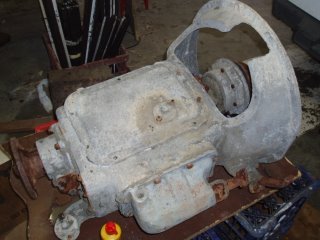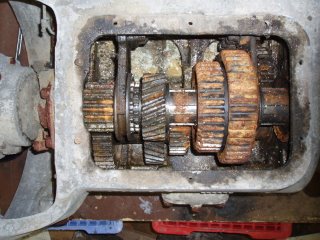The Mystery Gearbox
There is no mystery about the gearbox which came out of 1615: it's a normal, post-war, CX19 gearbox, GB211 in Albion terms, with straight-cut teeth on all gear wheels. As mentioned in the blog post dealing with the engine removal, this gearbox appears to be in beautiful condition, but it is not the gearbox that 1615 was built with. This is only to be expected, as the DRTT would fit whatever gearbox it had to hand at the time of overhaul, and as far as dimensions are concerned pre-war and post-war Albion CX19 boxes are interchangeable.

A VIEW OF THE MYSTERY BOX, SHOWING THE DISTINCTIVE CLUTCH THROWOUT (withdrawal) MECHANISM THROUGH THE ACCESS HOLE AT RIGHT AND THE OIL FILLER NECK AT LEFT. THE GAP IN THE TOP OF THE CASE IS JUST THAT: A PIECE BROKEN OUT, BUT THIS CAN BE REPAIRED BY WELDING.
Craig had found some months ago at the Tramway Museum, Loftus, another gearbox which we easily identified as of Albion make because of its clutch withdrawal mechanism and oil filler neck. The surprise came when we took the top cover off and peeked inside: it had helical-cut teeth on the third speed wheels! This initially sounded very exciting, because I was aware that pre-war CX19 gearboxes had the " silent third" feature, achieved by the use of helical gears. But further research in the Instruction Book for CX Group Commercial Vehicles indicated that such boxes had helical gears on top speed as well........

THE RUST CREATED BY PARTIAL FILLING WITH RAINWATER LOOKS WORSE THAN IT REALLY IS: THE STEEL USED IN GEAR WHEELS IS OF SUCH HIGH QUALITY THAT IT IS ALMOST STAINLESS. THE HELICAL TEETH ON THIRD SPEED WHEELS ARE CLEARLY VISIBLE, AND THE STRAIGHT CUT TEETH ON TOP SPEED (left, at the front of the gearbox) ARE OBVIOUS.
So what had we found? I decided to pull down the mystery gearbox with a view to deciding whether it might be made good enough to fit in place of the not-really-original post-war box. The peek inside with the top cover plate removed had already revealed major wear on the 2nd speed gear teeth. But this was not a problem as the stash of Albion spares acquired from Toronto Bus Service in the 1970s included a pair of 2nd speed wheels.
The box had sat outside, with no oil in it for many months and was partly full of rainwater. This made it look bad, but it dismantled fairly easily and revealed that apart from the 2nd speed wheels the only serious wear was in the splines of the countershaft, where the third speed wheel sat. And the first speed wheel at the rear of this shaft was decidedly chewed-looking.
Not having a spare countershaft, I decided to remove the countershaft (also known as the layshaft) from the post-war Albion box which I had kept aside for 30-odd years as a source of spares should my Albion, ex-DRTT m/o 1892, need them. This shaft proved to be in quite nice condition, with one tiny difference: its rear support bearing was a double-row roller bearing, as opposed to the single-row bearing found in the earlier, mystery, gearbox. This will not be a problem, as the shaft can be transferred along with its longer bearing housing to the casing of the mystery box.

THE CASE OF THIS PRE-WAR GEARBOX IS SMOOTHER AND CLEANER LOOKING THAN A POST-WAR BOX WHICH HAS HEAVY RIBBING IN MANY PLACES. THE PLATE ON THE SIDE IS WHERE A GEARDRIVEN TYRE PUMP CAN BE FITTED IF DESIRED. Compare this photo to the photos of a post-war case in Bulletin 9, www.albioncx19project.org.uk
So we now have the ingredients to build up a sound, rather special gearbox with the silent third feature. This will probably make it the only one of its kind to survive in the world.
My friend Paul Adams in Scotland, restorer of Sydney m/o 1877 and author of "Albion of Scotstoun", is in contact with other Albion experts who may be able to give the story on this odd gearbox, with helical gears on third speed but not on top.
Watch this space.
By the way: the excessive wear on the second speed wheels in the 'helical' box indicates to me that it had suffered from a trick used by most of the old drivers, to make life easier: changing gear without the use of the clutch.
This can be done, by judicious timing and synchronising of road speed and engine revs. but I have always suspected that it would result in tapering of the teeth on gear wheels due to the need to use slight extra pressure on the gear lever to push the gears into mesh with the inevitable slight load on them. Second speed teeth are badly tapered, the the dog clutches for top and third similarly, and the countershaft at the area where the third gear wheel sits has considerable rotational free play.

A VIEW OF THE MYSTERY BOX, SHOWING THE DISTINCTIVE CLUTCH THROWOUT (withdrawal) MECHANISM THROUGH THE ACCESS HOLE AT RIGHT AND THE OIL FILLER NECK AT LEFT. THE GAP IN THE TOP OF THE CASE IS JUST THAT: A PIECE BROKEN OUT, BUT THIS CAN BE REPAIRED BY WELDING.
Craig had found some months ago at the Tramway Museum, Loftus, another gearbox which we easily identified as of Albion make because of its clutch withdrawal mechanism and oil filler neck. The surprise came when we took the top cover off and peeked inside: it had helical-cut teeth on the third speed wheels! This initially sounded very exciting, because I was aware that pre-war CX19 gearboxes had the " silent third" feature, achieved by the use of helical gears. But further research in the Instruction Book for CX Group Commercial Vehicles indicated that such boxes had helical gears on top speed as well........

THE RUST CREATED BY PARTIAL FILLING WITH RAINWATER LOOKS WORSE THAN IT REALLY IS: THE STEEL USED IN GEAR WHEELS IS OF SUCH HIGH QUALITY THAT IT IS ALMOST STAINLESS. THE HELICAL TEETH ON THIRD SPEED WHEELS ARE CLEARLY VISIBLE, AND THE STRAIGHT CUT TEETH ON TOP SPEED (left, at the front of the gearbox) ARE OBVIOUS.
So what had we found? I decided to pull down the mystery gearbox with a view to deciding whether it might be made good enough to fit in place of the not-really-original post-war box. The peek inside with the top cover plate removed had already revealed major wear on the 2nd speed gear teeth. But this was not a problem as the stash of Albion spares acquired from Toronto Bus Service in the 1970s included a pair of 2nd speed wheels.
The box had sat outside, with no oil in it for many months and was partly full of rainwater. This made it look bad, but it dismantled fairly easily and revealed that apart from the 2nd speed wheels the only serious wear was in the splines of the countershaft, where the third speed wheel sat. And the first speed wheel at the rear of this shaft was decidedly chewed-looking.
Not having a spare countershaft, I decided to remove the countershaft (also known as the layshaft) from the post-war Albion box which I had kept aside for 30-odd years as a source of spares should my Albion, ex-DRTT m/o 1892, need them. This shaft proved to be in quite nice condition, with one tiny difference: its rear support bearing was a double-row roller bearing, as opposed to the single-row bearing found in the earlier, mystery, gearbox. This will not be a problem, as the shaft can be transferred along with its longer bearing housing to the casing of the mystery box.

THE CASE OF THIS PRE-WAR GEARBOX IS SMOOTHER AND CLEANER LOOKING THAN A POST-WAR BOX WHICH HAS HEAVY RIBBING IN MANY PLACES. THE PLATE ON THE SIDE IS WHERE A GEARDRIVEN TYRE PUMP CAN BE FITTED IF DESIRED. Compare this photo to the photos of a post-war case in Bulletin 9, www.albioncx19project.org.uk
So we now have the ingredients to build up a sound, rather special gearbox with the silent third feature. This will probably make it the only one of its kind to survive in the world.
My friend Paul Adams in Scotland, restorer of Sydney m/o 1877 and author of "Albion of Scotstoun", is in contact with other Albion experts who may be able to give the story on this odd gearbox, with helical gears on third speed but not on top.
Watch this space.
By the way: the excessive wear on the second speed wheels in the 'helical' box indicates to me that it had suffered from a trick used by most of the old drivers, to make life easier: changing gear without the use of the clutch.
This can be done, by judicious timing and synchronising of road speed and engine revs. but I have always suspected that it would result in tapering of the teeth on gear wheels due to the need to use slight extra pressure on the gear lever to push the gears into mesh with the inevitable slight load on them. Second speed teeth are badly tapered, the the dog clutches for top and third similarly, and the countershaft at the area where the third gear wheel sits has considerable rotational free play.

